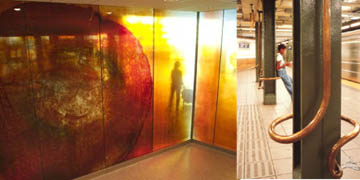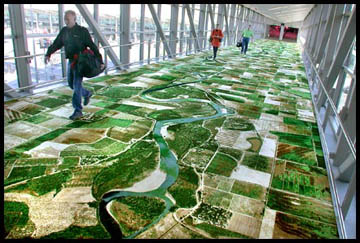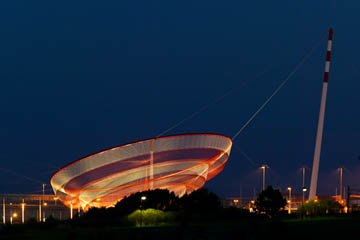In the comments for a previous blog, Margaret Koscielny wrote:
“Public Art” is an oxymoron; just like “Computer Art.”
Weiss responds:
“Art can be privately discovered by the artist and be meaningful to others, therefore “Public Art”
Margaret Koscielny ellaborated: (Koscielny Website)
“I feel that “Public Art”, as a term, is an oxymoron. Perhaps the solution is to allow public sentiment for memorials, or statements of common outrage, to be channeled towards specific commissions, instead of the open-ended kind, now common. Let the public subscribe with their own money, instead of taxpayer’s money, to the erection of a “monument” to their sentiments. Then, whatever might be produced by the artist might be “art” instead of the pablum which “Public Art” has become.
Weiss responds:
A lot of government sponsored or supported public art is of lower quality, but so is a vast amount of privately supported art – public and private. Adding vitality to the public realm can come as sensitive decoration or angry sentiments.
Reis Niemi responds (Niemi Website)
Public Art is not an oxymoron.
Some of the work is indisputably Art, even if much of it is not.
And most of the work is displayed in public.
Thus, both words are true when discussing the work.
Calling it an oxymoron would mean that the two words contradict each other- which, of course, they dont. They might slide by each other in the night, unawares, but contradiction is something else.
I assume what is meant is the writer doesnt like public art.
But as we have discussed here before, there are at least three competing definitions of public art, and unless you specify which one you are talking about, its kinda meaningless.
There absolutely positively is a legal category of art, called Public Art, that is funded by 1% ordinances around the country, and produces actual physical objects that are not oxymorons.
Nobody says you have to like em. But they are real, and the name legally and in common english applies.
What is missing from the original article, and from Ms. Koscielny’s mind, I would guess, is GOOD public art.
I can suggest a few pieces I think fall in that category, and I am sure Glenn can add a few more. By actually looking at the best stuff that is being done these days, it is possible to see what Mr. Petrovich has missed on Slate.com. (See Aesthetic Grounds Comment) Some of which may change his mind.
I personally recommend the following-
Buster Simpson– any of it- its all smart, snappy, and relevant-
Claudia Fitch– anything she does rocks, but this piece, inspired by roman statuary, is great-

Linda Beaumont– Travelling Light, SeaTac Airport-
Its public, its art, and its goddamn gorgeous. Bobo IS the goddess.
James Garvey– Lariat Seat Loops, IRT station, 33rd St, NYC-
Elegant, subtle, functional,art, and its in public. He draws a line in space, right thru the subway station, and you can sit on it to boot.

Sayed Alavi– Flying Carpet- Sacramento Airport
I dream of flying…

Janet Echelman- She Changes, Porto, Portugal
If this piece dont knock your socks off, you need a podiatrist.
I am also a big fan of many projects by Vito Acconci, Dan Peterman, the ART GUYS, Bob Irwin, Tom Otterness, and my lovely wife, Sheila Klein.
Virtually any public project by any of the above artists disproves the oxymoron theory.
Lots more good stuff out there as well, along with loads and loads of crap.
Margaret Koscielny reponds
As one who was commissioned to produce 4 walls, 9 x 13 feet for the Atlanta airport in 1979, I can assure you I know exactly what the “public” in Public Art means. As one who also produced numerous works for “public” spaces in Corporate headquarters and offices, I can also assure you that there is not much difference, when it comes to respecting the art.
My argument with most “public” art is that it is not respected, taken care of, nor, in many cases, chosen with any sensitivity to the environment in which it will exist. I do not necessarily mean the aesthetic environment, but the cultural and educational environment.
In my community, art created for public spaces has been most successful in the libraries, where the “commissioners” know their “public.”
There are successful art works created for public spaces. Europe is full of them, and occasionally, some of the more sophisticated cities in this country. Even so,
where is the care that is needed once the work is up? Where is the educational effort to inform and explain the work to people who have no acquaintance with art?
This country has a poor history with generalized art education which would afford the “public” the
ability to respond to art which is “unfamiliar” and
challenging.
I am not against art in public places; I am against the visual “pablum” which is served in trying to please the “public.”
Ries Niemi responds
Everything you say is true, and could equally well be said about Painting.
I was in a motel the other day, with 2 paintings- and they were visual pablum, which were obviously placed there to please the “public”.
I am not against Painting- I am against BAD PAINTING.
The reality is that a few civic agencies do a great job of maintaining public art, and many others do not- much like bridges.
For public art to be successful, it is not enough to do the exact same work you would do in a gallery show- you must design the work from the beggining so it will survive, unloved and unattended, out in the real world.
Just as a painter must know his or her media and materials, a public artist must understand bi-metallic corrosion, what graffiti cleaning chemicals will do to their work, the lifespan of powder coating, how to manage a structural engineer to get invisible fasteners, and many more practical, real world things.
If it was easy, everybody would be doing it.
I am sorry, but no art, public or private, can change the art education of the general public.
I think the expectations and hurdles you place on public art are far more than you would put on the latest painting at MOMA.
There are many more compromises, and difficulties in making successful public art, and so, naturally, the great successes are few. But they are certainly there, right here in America.
PS- I have travelled extensively in Europe as well- and seen quite a few complete dogs of public art there- they dont have a magic bullet either.
Public Art, Public Space

Margaret Koscielny writes
As one who was commissioned to produce 4 walls, 9 x 13 feet for the Atlanta airport in 1979, I can assure you I know exactly what the “public” in Public Art means. As one who also produced numerous works for “public” spaces in Corporate headquarters and offices, I can also assure you that there is not much difference, when it comes to respecting the art.
My argument with most “public” art is that it is not respected, taken care of, nor, in many cases, chosen with any sensitivity to the environment in which it will exist. I do not necessarily mean the aesthetic environment, but the cultural and educational environment.
In my community, art created for public spaces has been most successful in the libraries, where the “commissioners” know their “public.”
There are successful art works created for public spaces. Europe is full of them, and occasionally, some of the more sophisticated cities in this country. Even so,
where is the care that is needed once the work is up? Where is the educational effort to inform and explain the work to people who have no acquaintance with art?
This country has a poor history with generalized art education which would afford the “public” the
ability to respond to art which is “unfamiliar” and
challenging.
I am not against art in public places; I am against the visual “pablum” which is served in trying to please the “public.”
The question of ‘good’ vs ‘bad’ anything seems to require contextual qualifiers for it to hold meaning. This seems particularly true of public art, since it is, or at least should be, contextually-derived. How acutely a piece speaks to its place in the world seems the best measure of work. And, yes, durability is an issue.
The list of artists you’ve mentioned, Ries, seems like a pretty good start. All mentioned deal incisively with context. In the realm of sanctioned public work I’d also include the following: Martin Puryear, Steve Siegel, Ned Kahn, Richard Deacon, Janet Zweig, Dan Corson & Dennis Oppenheim. There’s many others, I’m sure, but these immediately come to mind.
Beyond fave rave lists, though, is this larger issue of contextual relevance. In an era of late monopoly corporate enviro-meltdown any work that doesn’t address the obvious (& the hidden, marginalized, degraded) in some thought-provoking, potentially motivating ways seems irrelevant.
As Glenn alluded early on within this exchange, perhaps broadening the definition of ‘public art’ is in order. Perhaps inclusion of such unsanctioned practitioners as BGL, Wooster Collective, Superflex, The Yes Men, Critical Art Ensemble or Center for Land Use Interpretation–those collectivists who are creating works outside the percent system with ephemeral means but memorable results.
And speaking of ethereal, what about those other senses? I’ve been a longtime fan of sound artists such as Max Neuhaus, Alvin Lucier, Bill Fontana, Robert Morris & Fluxus, finding sonic immediacy within a spatial context to be pretty darn alluring. Fontana’s ‘Harmonic Bridges’ @ the Tate or Neuhaus’s Times Square piece both made the hair stand on the back of my neck.
Also compelling are those ‘boundary crossers’ who work cross disciplines, with intense verisimilitude, such as Sam Mockbee, David Eckard, John Grade or Kevin & Jennifer McCoy.
There’s more, but I’ll leave it there for now. Keep writing y’all. Good blog.